In my long list of “favorite plants,” the African violet sits comfortably somewhere near the top.
That’s because of its profuse and reliable blooming, the ease of care, and the mystique of being a plant native to Africa. But there’s a more personal reason in there, too.
When I was in charge of maintaining greenhouse stock at an old job, I took special pride in the condition of the African violets.
For close to four years I was handling hundreds of plants (in addition to the rest of our stock) and am proud to say I lost a mere handful.
They were also a favorite plant to bring home, and in the years I’ve spent caring for these tough yet delicate plants, I’ve learned the ins and outs of the African violet.
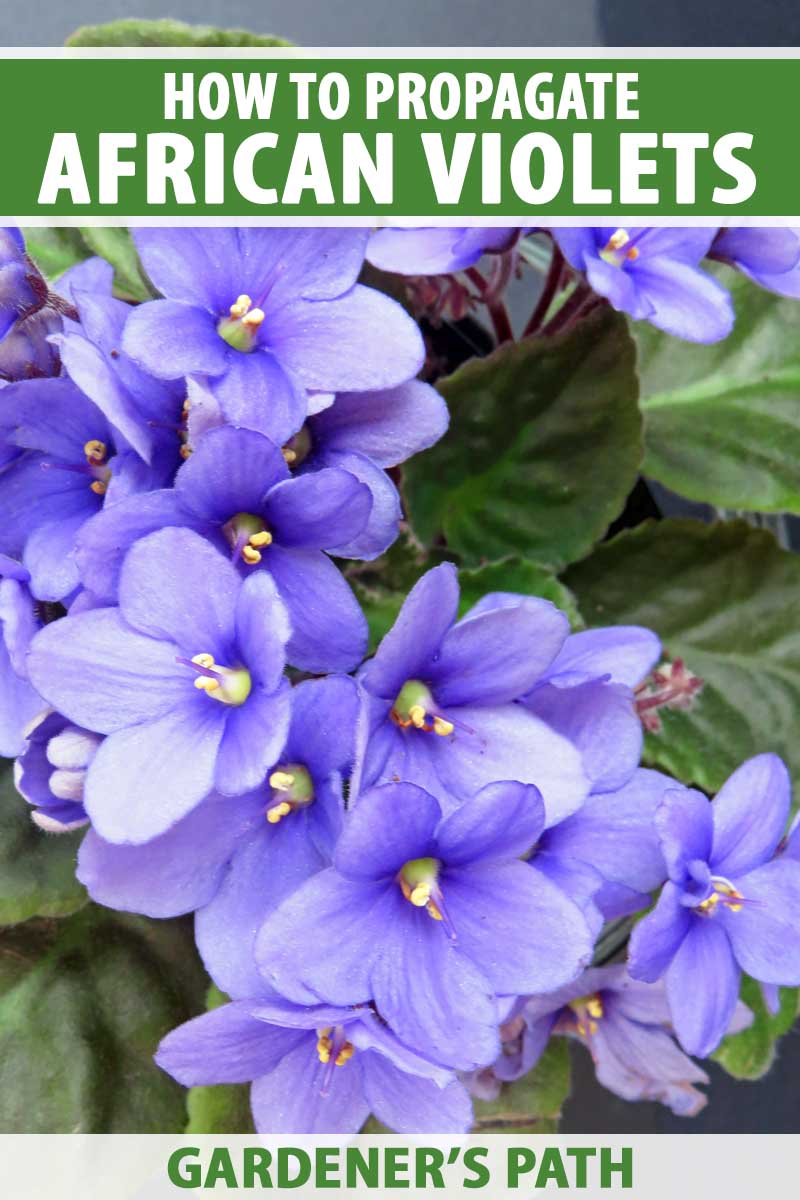
We link to vendors to help you find relevant products. If you buy from one of our links, we may earn a commission.
They have a well-documented history and are relatively easy to care for, but propagating them from cuttings is an exercise in pleasure.
Whether you need more violets in your own home, or are planning ahead towards Christmas, Mother’s Day, or Easter, establishing African violet cuttings is a surprisingly easy exercise.
What You’ll Learn
By the time you’re finished reading this, you’ll be armed and ready to start your own African violet assembly line!
Supplies and Equipment Needed
Propagating Saintpaulia is relatively easy. You only need a few items for the project:
- A host plant to harvest leaves from
- Rooting medium
- Rooting hormone (optional)
- A sharp knife, your pinching fingertips, or a pair of fine-tipped pruners
- A bowl for mixing soil
- Plastic 2-inch pots
- Plastic plant tags or other waterproof supports
- A clamshell to-go container made of clear plastic
The scale of this operation is up to you, the gardener. For simplicity’s sake I harvested leaves from a single plant, five total leaves for propagation.
When it comes to any kind of cuttings or seed growth, it’s always better to start with more than you think you need.

Garden Safe TakeRoot Rooting Hormone
That’s why I used a rooting hormone for this project, to help these cuttings establish themselves.
GardenSafe Take Root Rooting Hormone is one of my favorites, and it’s available on Amazon.
Auxins are a plant hormone located in the tip of a stem that encourage elongation. Applying a rooting hormone to plant cuttings artificially beefs up the supply of auxins and helps the plant to grow stronger roots.
For the rooting medium, I made my own. But you can also pick it up at your local nursery, or find a suitable mixture online.
I suggest Miracle-Gro Perlite combined with Miracle-Gro’s African Violet Potting Mix. I’ve always defaulted to perlite in the past.
The difference between it and vermiculite is insignificant, and I can also readily buy perlite in convenient eight-quart sized bags.
Miracle-Gro’s African Violet Potting Mix is excellent for many young plants. It offers a slightly acidic composition that drains well and is full of rich organic material, making it useful for more than just African violets. I’ve used it for other small projects when in a bind and it works just fine!
To stir it up, any household mixing bowl will do. (Shh, I used one from our baking set; don’t tell my fiance!) A bucket or planting container without drainage holes will also do the job.
For this kind of delicate work, I prefer to use pruners, like the Fiskars Softtouch Micro-Tip Pruning Snips. These are available on Amazon.

Fiskars Nonstick Softgrip Micro-Tip Pruning Snips
As for those plastic pots, drainage holes are a must, and you’re looking for something small.
I used a few two-inch pots that were leftover from some succulents I purchased a few months ago. Always save those pots! You never know when you might need them.
For each leaf, you’ll require one pot around the 2-inch size for this project.

Another lesson in Reduce, Reuse, Recycle – for those plastic supports, I used old plant tags. There always seem to be a few lying around. But plastic forks – or even toy Army men – could be used.
Finally, to create a mini greenhouse for your cuttings to grow inside, you will need a clear plastic to-go container, the clamshell variety.
It will need to be large enough to place your pots inside, and for the pots and the leaves they contain to remain upright when the lid of the container is closed. I got mine from the salad bar at a local grocery store.
10 Steps to Propagating African Violets
Now, let’s get started!
Step 1 – Prepare Your Rooting Medium
Saintpaulia prefers well-drained soil, but cuttings are even more particular.
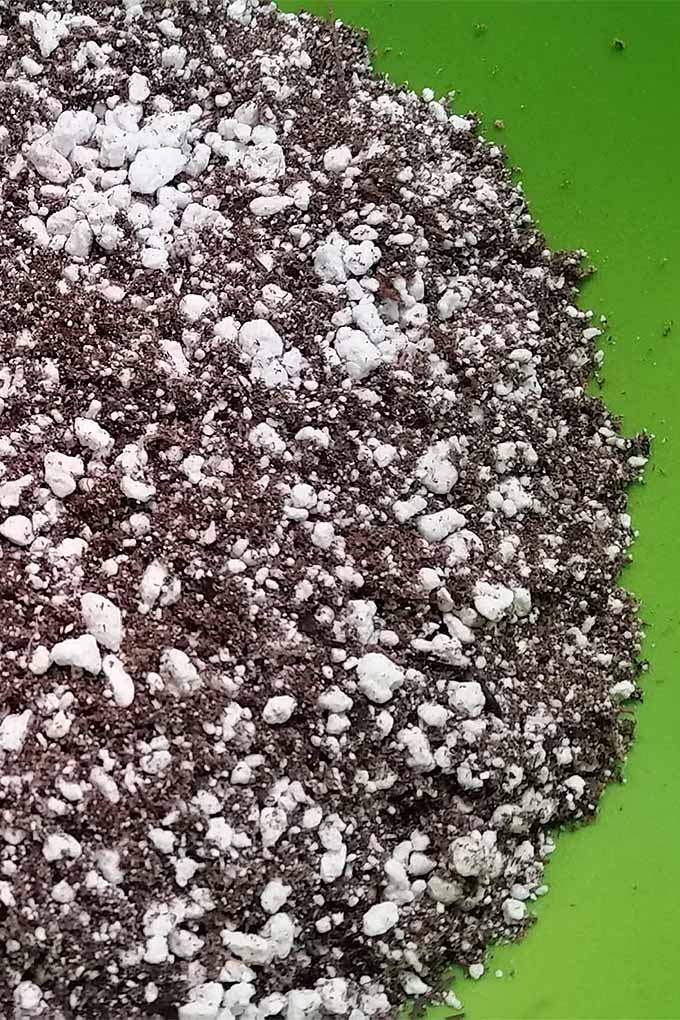
For this project I mixed two parts perlite to one part African violet potting mix. It should look like a delicious crumbled cookie concoction.
Step 2 – Add Water
Add some water to the rooting medium, just enough to be able to clump the mixture together into a barely-there clump.
Some people say to imagine it’s like oatmeal, but I’ve never grabbed a handful of oatmeal before. It feels more like a handful of sand when you’re building the perfect sandcastle.
Step 3 – Fill Your Pots
Fill the two-inch pots (or whatever size you have) with the rooting medium. Use a pencil or any similarly-sized object to poke holes through the soil. You’ll be placing the leaf stems in here.
Step 4 – Choose Leaves
Remove mature and healthy leaves from the host plant. These leaves should be well-developed and free from any signs of pest or disease issues.
Select leaves from the middle row of the plant to use as cuttings. The leaves forming from the very center of the plant are the youngest, and the largest leaves on the outside are the oldest. The leaves in those middle rows are the best candidates for cuttings.
Make sure to remove as much of the leaf stem as possible from the crown to prevent rot in the host plant.
Step 5 – Prep Leaves
Shorten the leaf stems to a length of about one inch using a knife, your fingernails, or sharp snips.
Step 6 – Apply Rooting Hormone
Before we get started with this step, recognize that rooting powder is a very mild irritant. If ingested, it can cause stomach discomfort and it can irritate any mucous membranes it comes into contact with. Gloves and eye protection are always a safe precaution, but not a requirement.
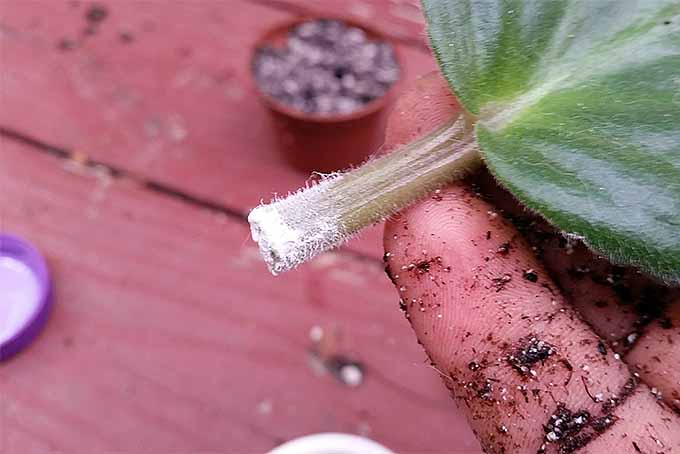
Lightly dip each stem into the rooting hormone. I’ve always dipped my cuttings right into the bottle of hormone powder, but you can shake some of the hormone onto a flat surface if you prefer. You don’t need to coat the entire leaf stem in hormone powder, as long as about half of the length of the stem gets a fine coating.
You don’t need much, only a light coating. Carefully tap off the extra powder from the leaf stem. Like soy sauce, a little rooting hormone goes a long way.
Step 7 – Potting Up the Cuttings
Carefully place the stem of each leaf into the rooting medium. The blade of the leaf should just touch the surface of the rooting medium. The new plant rosettes will form from this area.
Firm the medium around the stems so that the leaves are upright and in place.
Step 8 – Add Support
Use the plastic plant tags (or whatever support you have chosen) to act as a stand, ensuring the leaves do not collapse into the soil.
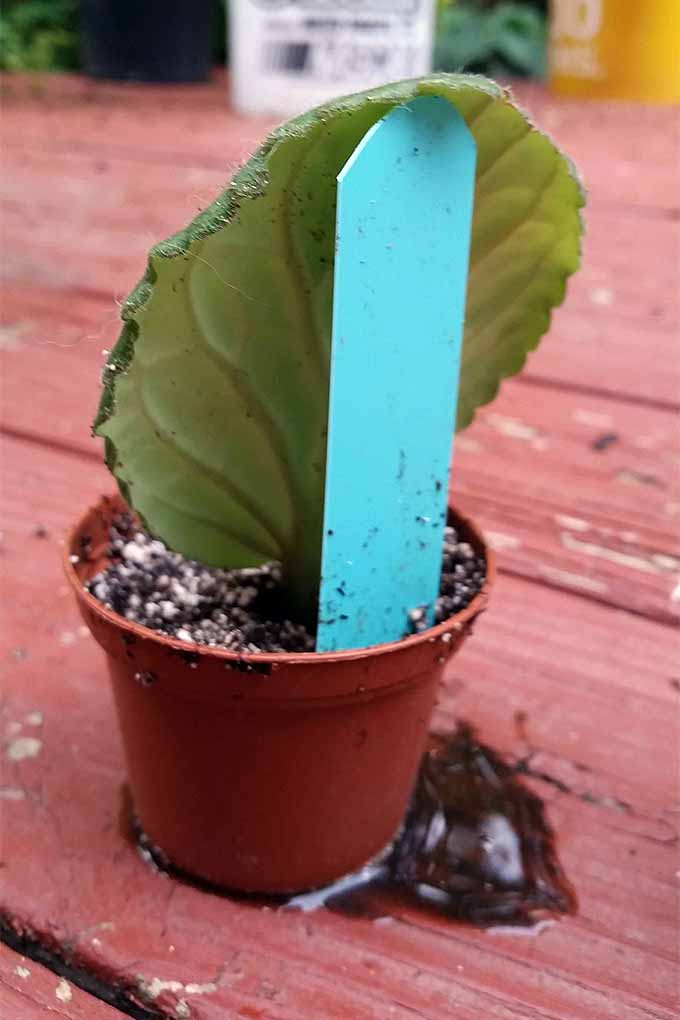
If the leaves you cut are too tall to fit inside the container, there’s an easy fix for that.
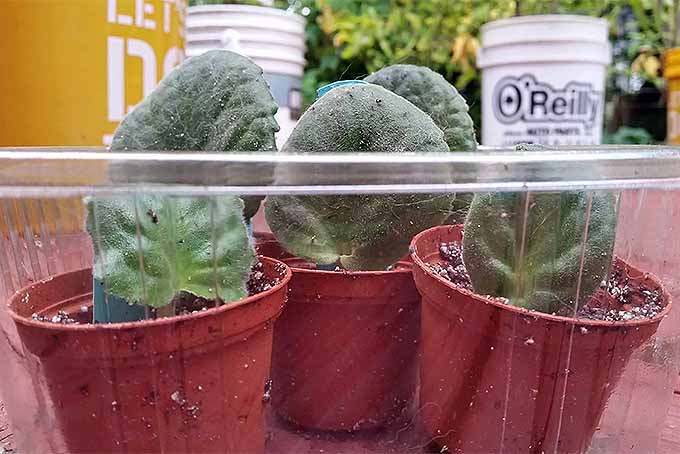
You can make one clean cut across the top of each leaf, effectively slicing away the top half of the leaf.
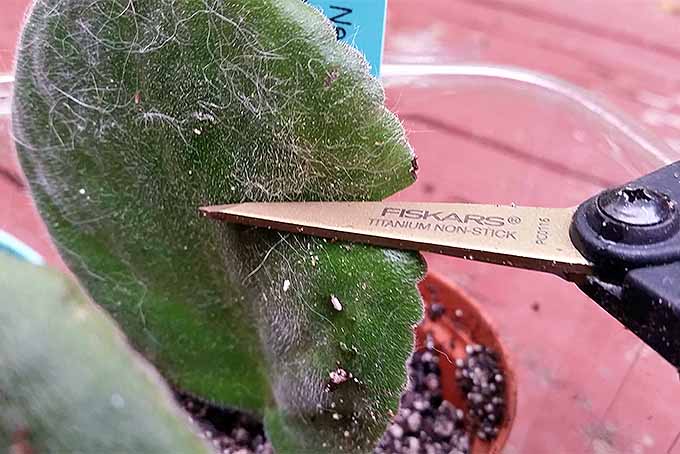
This will not affect its ability to take root.
Step 9 – Create a Mini Greenhouse
Place the potted and soon-to-be-beautiful African violets into the clamshell containers. Carefully close the lid tight, ensuring that the cuttings and pots all fit inside of the container.
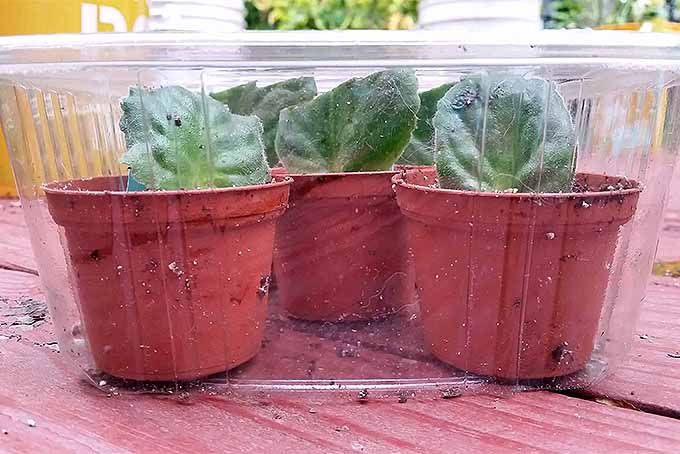
It is vital that the container can close tightly, locking up the potted cuttings in a warm and humid environment.
Position this container in an area that is bright, but not hot.
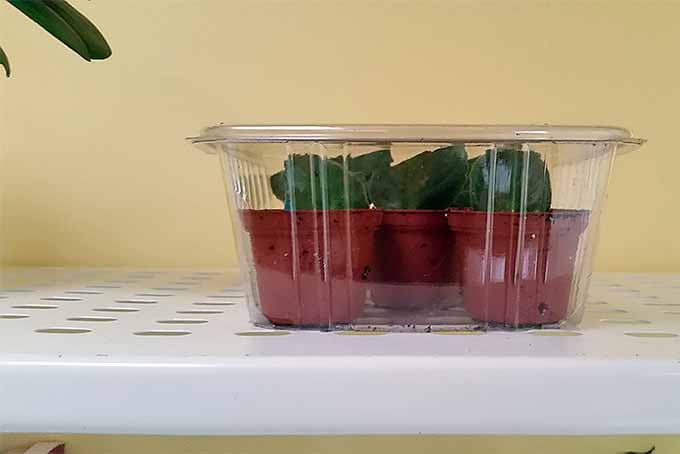
Your ultimate goal at this point is to do your best to mimic the natural habitat Saintpaulia originates from. By placing the plants in a well-drained rooting medium and containing them in a mini-greenhouse with some bright light, you are effectively duplicating their native cloud forests.
Open the container occasionally to air out excess moisture or to add more, as necessary.
Find more tips on creating indoor mini-greenhouses here.
Step 10 – Transplant Your New Violets
After a period of approximately eight weeks, your leaves should be developing into proper violets. They should have developed a few baby leaves at the base of the plant (seriously, they’re adorable) and have reached a height of about two inches.

Transfer these plants into a one-size-up container with a one part African Violet Mix and one part rooting medium mix, the same as the one we put together for the cuttings.
Final Thoughts
I love African violets. They remind me of the grandness of Africa. I may never delve into the jungles of the Congo or race across the Serengeti on a wildebeest’s back, but at least I’ll have my Saintpaulia to help me imagine the wonder of it all.

And in a few months I’ll have perfectly fine gifts to give to people for holidays and birthdays – and you can bet your bottom dahlia I’ll teach them how to propagate their own cuttings. Then we’ll all have something in common.
How are your cuttings doing? Please share with us in the comments section below!
And if you love home propagation, check out these articles next:
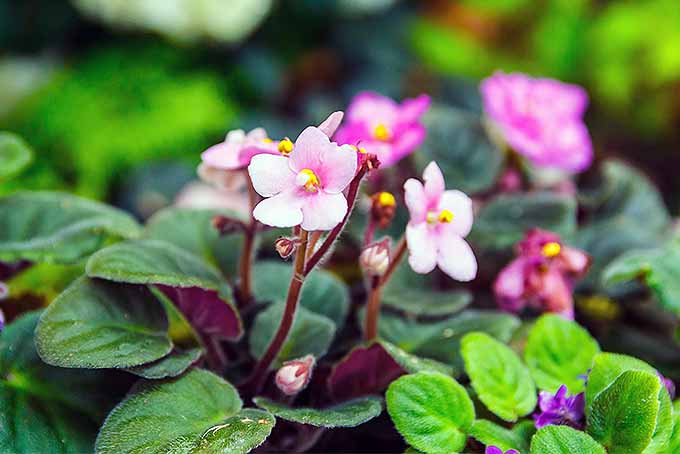

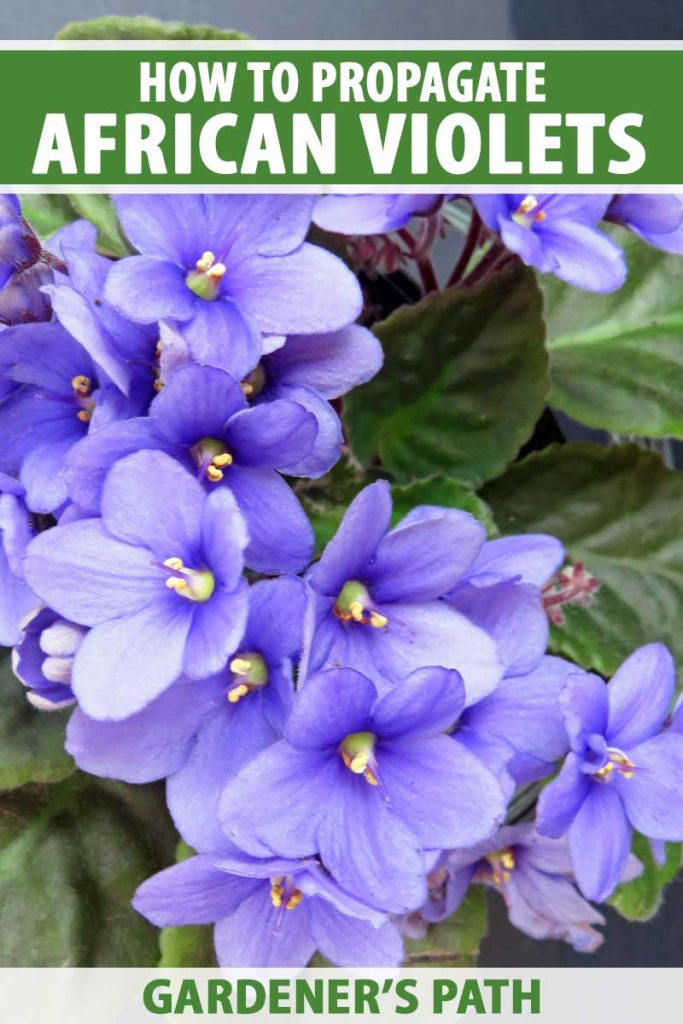
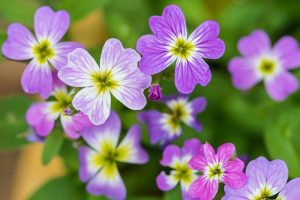


I love African Violets very much and I really enjoyed your article . I have a plant that I have had for almost 5 years. It is a great boomer but the stem has gotten so long that it won’t stand up right anymore. I know it sounds dumb but is there any way try to re-root it by cutting the stem off? Just a thought. I may have to try to start a plant from a leaf cutting. Thanks for any info or help you have.
Hi Ruby, thanks for reading! It sounds like you’re describing something called a neck. It isn’t necessary to re-pot violets with a neck. That’s up to you and your preferences! But if you want to re-pot your plant, here’s how. To re-pot an African violet with a neck, remove the plant from its container. Your goal is to remove the bottom of the root ball in an an amount equal to the length of the neck; in other words, if your violet has 1″ neck you want to remove 1″ of soil and roots from the bottom of the root… Read more »
Awesome post! This was exactly my question as well – re how to deal with neck of my mature and beautiful African violet. I appreciate and will try what you suggested! Many thanks! 🙂
I did rot my stem off once using this method but I didn’t throw out the plant. To my delight, a new plant grew up from the stem about a month later.
Thank you for such a great article. When the baby leaves appear do you cut the larger one? Thank you.
Matt, thank you for the propagation information. As for your info on watering, you said, “…the inversion method, is most effective.” But you didn’t explain how to do that. Could you please elaborate?
Sorry if this was confusing! As described in the article, inversion is a method of watering that involves setting a pot with holes in the bottom into a container of water to allow it to be absorbed from the bottom up.
As an addicted propagator of African Violets, I enjoyed your article. I currently have about 40 babies growing all over my house and am now experimenting with a few things such as use of supplemental grow lights and containers that won’t break the budget with good success (eggs shells that come with their own clam covers. I am entertained by the fact that one leaf will produce as many as three or four new plants. But what confuses me is the varieties that do not grow from the center crown into a circular manner, but rather as other plants do… Read more »
QI rooted my leaves in water and is there a specific planting method for them?
Hey there! Nice work on getting those roots started. I’ve had the best luck when the roots are about one-half inch long. Too much longer and the plant could have a difficult time establishing, and roots that are shorter can be far too delicate for planting. If the roots are the right size, you can plant the leaf directly into its intended pot. I’d shoot for a four inch pot rather than a smaller or larger one. A four inch pot seems to be the ideal “not too big, not too small” size for African violets. The soil should be… Read more »
I have beautiful plants, and they almost bloom all year long. I put a few leaves in water, add water when needed, and my last check, I notice small tiny green leaves under water. I never seen that before. My violets are crowded, and they reseeded themselves last summer. Now I have dozens of new babies crowding my bigger pots. When would be the best time to replant my babies?
Wow, leaves under the water? Very interesting! I’ve never seen that, what a funky happening. It can be tricky to get your violets to bloom so much, I’ve only been able to get one plant to do that for me, but I’ll take it. You must have the violet touch! So the fun thing with African violets is that they only bloom when root bound, so if you re-pot them it’ll take a few months before they start to bloom again. That said, if you are going to replant them and carefully divide the multiple crowns, do it during the… Read more »
I am fairly new to violets and have about 26 I have propagated from my original two. I get the green growth everytime and I just plant it all under the soil and they pop up in a few weeks. I am going to leave the next one in water just to see what happens.
Hi Matt,
Thank you for all the information. I have a violet leaf I stuck in water to see what would happen. 3 weeks later it has small roots but to my surprise the leaf steam is growing tiny baby leaves under water. Now what? Do I keep it under water till the roots are longer? Should I keep it submerged until the baby leaves are bigger? If so how big and how to I eventually plant in dirt? Thank you again.
Clancey Moore
A little confused . How much or do you water the leaf while it is in the container (mini greenhouse)?
Hey Rebecca, thanks for the question here. The mini greenhouse shouldn’t have too much water in it, but it should never dry out completely. I recommend filling the bottom of the container with about a quarter inch of water with the “roof” of the greenhouse open. Allow the soil to soak up the water completely. Keep the “roof” off for as long as the soil around the leaves is still wet to the touch. This can take a day or two. Once the soil begins to feel damp to the touch instead of wet, you can close the roof of… Read more »
The rooting hormone is unnecessary for African violets. In fact, you can root them in water. When rooting in medium , if the cut is made diagonally on the upper surface of the leaf petiole, you are likely to get more clones.
I just noticed a new plant forming on the neck of my violet. Do I leave it or remove it? The main violet is healthy and happy.
Good question. I’d suggest leaving it for now and monitoring its growth, and if the parent plant begins to look a little stressed it’s time to remove the new one. I generally trust plants to know what they’re doing and only intervene if it’s necessary. Let me know how this progresses, it’s an interesting scenario!